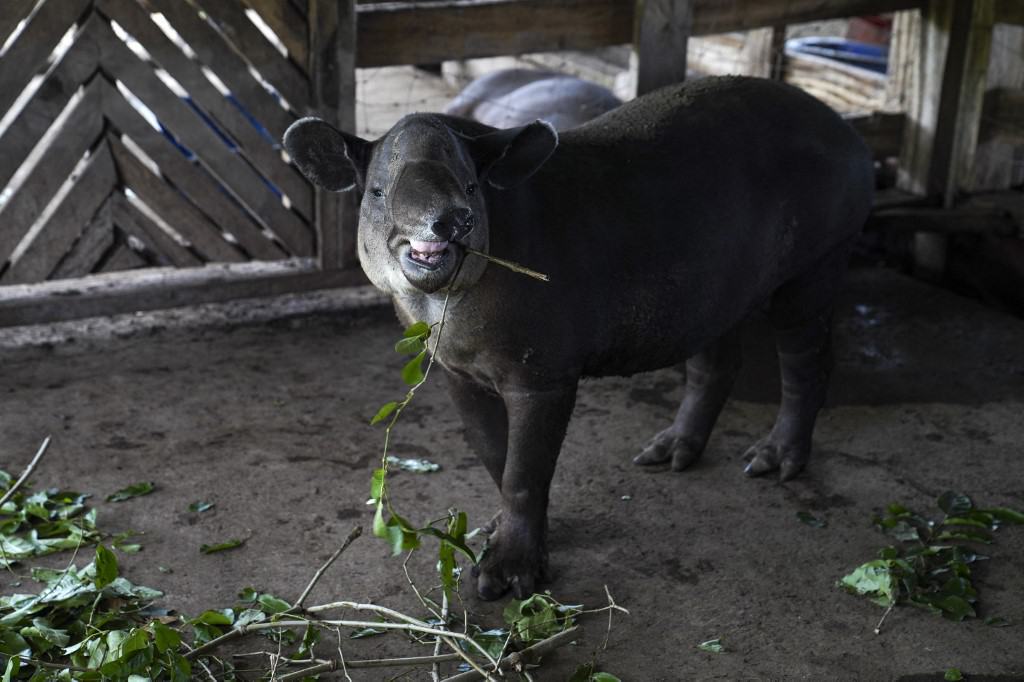Agostina is a tapir that silently moves her heavy body while eating leaves in a forest in western Nicaragua, where she was released on Friday as part of a preservation effort.
She was born in captivity four years ago and before going into the forest, vets fitted Agostina with a tracking collar so rangers can monitor her movements in her new habitat away from her main predator, humans.
The tapir or danta stops her walk on the path over the watercourse of a spring, attracted by the abundant branches, leaves and roots she tears off to feed on with her elongated snout that looks like a small trunk.
The initiative is “to breed endangered animals and we chose the tapir or danta,” said Eduardo Sacasa, a 75-year-old veterinarian who leads the program “Let’s Save the Tapir in Nicaragua” and who directed Managua’s zoo for 25 years.
“It is a very interesting animal, it is the one most in danger in Nicaragua,” adds Sacasa, who estimates there are only about 400 tapirs left in the country. Tapirs feed on fruits and vegetables and enjoy the water in the Cervantes Wildlife Reserve, about 190 kilometers west of Managua.
The reserve has a forest of more than 1,600 hectares and in it, before Agostina, six tapirs have been released in three years, although most are still in the zoo.
From Captive to Wild
\Weighing about 420 pounds, 1.5 meters long and 1.3 meters tall, Agostina quickly adapts to freedom. When she dives into the water, the rangers make noises around her so that the animal goes deeper into the forest.
The Central American tapir (Tapirus bairdii) is a herbivorous mammal of the tapir family, whose original habitat is distributed from southern Mexico to Colombia.
Hunting, deforestation caused by urbanization and the advance of crops have impacted their natural habitat and increased the risk of extinction of this species, related to the horse and the rhinoceros. The figure of the tapir is present in Latin American popular culture, as in Venezuela where the deity Maria Lionza is shown riding a danta.
The main predators of tapirs, in addition to humans, are jaguars and pumas. In the reserve, tapirs have gone from being tame captive animals to free and elusive tapirs in the wild.
There are also matings and one of the females gave birth a year ago to an offspring after 14 months of gestation. In a month, another tapir will be released in the reserve to complete nine specimens of this mammal.
Sightings
Francisco Martínez, 38, one of those in charge of the wildlife reserve, said that every day he uses an antenna for satellite collars in order to monitor the route that Agostina and other released tapirs follow in the forest.
“For us it is a great thing that (Agostina) is free, that she walks freely, that we no longer have to keep her in captivity. We take care of the area where they walk and monitor them,” he comments.
The caretaker added that they “have educated people from nearby communities so that they do not touch the dantas, do not harm them and know that we are here in a struggle to conserve them.”
According to the supporters of the preservation effort, more than 150 years ago there were tapirs in Chinandega and the western area of Nicaragua, but they disappeared due to human predation.
In the future the reserve will be a place “for sighting for scientists, biologists, anyone who wants to know about tapirs,” adds Sacasa, who is proud that up to “nine tapirs that walk freely” can be seen in that area.






